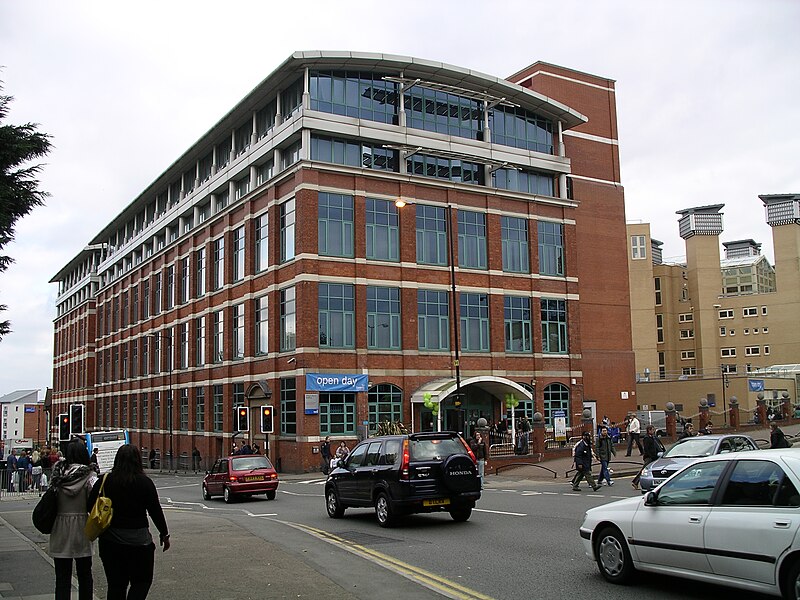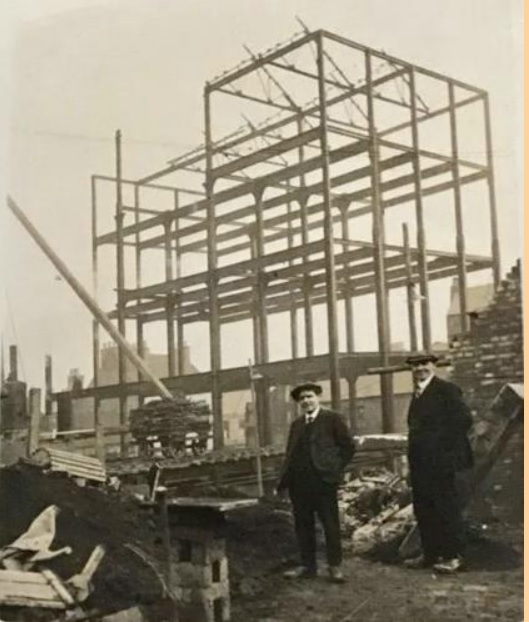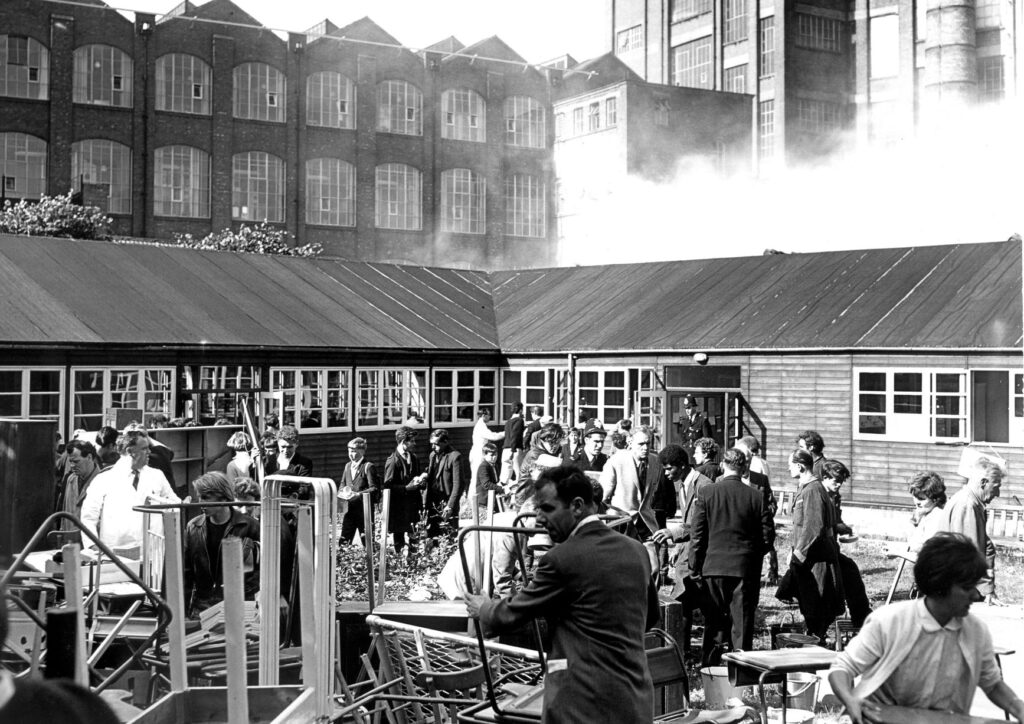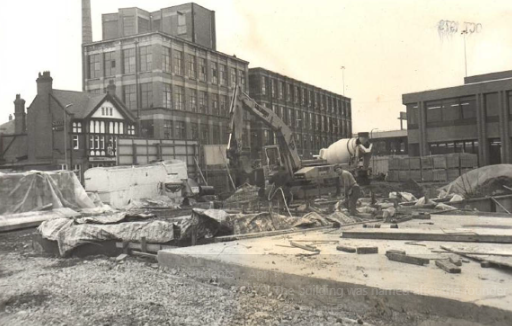
Malvern Carvell published this interesting story about the William Morris Building on the Visit Historic Coventry Facebook page in April 2023. The building, in Gosford Street, is now occupied by Coventry University. Malvern writes….
I had always assumed that this building was built for Morris Motors, however delving into the history of the site and the building tells a much more complex story.
In 1880 Llewelyn Aviss, a Coventry cigar retailer (and city councillor from 1894-1903), set up a factory at the rear of 90 Gosford Street to make his own cigars. The business flourished and before long the firm was employing over 200 workers.
In 1889 Henry Hewitt, a watchmaker and publican, and Fred Kerby, also a watchmaker, established the Roulette Cycle Company to the rear of 85 Gosford Street. In 1896 Henry Hewitt stepped back and the company re-formed as the New Roulette Cycle Company Limited with Fred Kerby continuing as Managing Director with the backing of his brother-in-law Jabez Kerby Newsome from the famous watchmaking family. In 1896 it was producing 5,000 cycles a year.
The cigar factory closed in 1906 and then in December of that year there was a major fire at the Humber works in Far Gosford Street forcing Humber to relocate to Gosford street whilst their new factory was planned and built in Stoke. The Gosford Street site was subsequently used by the Arno Motor Co. Arno were fairly short lived, making motorcycles and developing a car with a 25HP White and Poppe engine, which was not successful. By 1913 the company was in difficulties and left Gosford Street for premises at Hillcross. They traded for two more years making a limited range of motorcycles known as Red Arno before folding. Roulette meanwhile continued to operate from their premises and between 1911 and 1914 were producing motorcycles with a duplex frame invented by Fred T Robb and fitted with JAP engines. Operations ceased soon after the commencement of hostilities in 1914.
Meanwhile over in France Hotchkiss et Cie had been founded in 1867 by an American, Benjamin Berkeley Hotchkiss (1826-1885). Hotchkiss had developed a number of cannon and artillery pieces during the US Civil War and in 1867 he came to France where he set up a company near Rodez and developed a revolving barrel machine gun. The company moved to St Denis in Paris and as well as developing machine guns it started to design its own cars. The key players in the business by this time were Monsieur L. V. Benét and his designer Monsieur Mercié. In the early 1900s the company started producing machine guns in the US under the name Benét-Mercié but the guns were not successful and production ceased before the start of WWI, however some guns were used by the U.S. Navy in the war. Also involved in the company was William Henry Squire born in Great Torrington, Devon in 1841. He had moved to Paris in the 1870s and married Madeleine Marie Girardin. In the summer of 1907 Squire, came over from France to study British manufacturing methods and visited Daimler and Alfred Herbert and was extremely impressed with what he saw.
At the outbreak of war, the company was concerned that their factory in Paris might be overrun and so relocated to Lyon, but at the same time the British Government invited Hotchkiss et Cie to open up a British operation. Coventry was the natural choice and in February 1915 the company moved into the old Arno factory in Gosford Street. The company wanted a rising star within the firm, Henry Mann Ainsworth to take control. Henry was born in Buxton in 1884 and had moved to Paris in 1904 where he joined Hotchkiss, but at the onset of war immediately signed up for the British Intelligence Corps where he worked as an interpreter and translator liaising between the British and French forces. As Ainsworth was otherwise engaged, Hotchkiss “poached” Mr Alfred John Dawson, who had previously worked for Daimler and Hillman to be the General Manager and in less than four months the company was producing 100 guns a week. By December 1915 they had over 400 employees and were making the Hotchkiss Mk. 1, a variant of the French made M1909 machine gun.


In January 1916 Mr Dawson returned to Hillman, where he went on to design vehicles of his own (In 1919 he set up the Dawson Motor Company at Clay Lane producing four models with bodies made by Charlesworth Bodies. In total 70 cars were made but he had to abandon further development when the company’s financial director was killed in a car crash. Malcolm Campbell was the company’s London agent at the time.
In 1921 the premises and tooling were sold to Triumph Motor Co. Dawson then emigrated to Sydney, Australia where in 1935 he became President of the Australian Institute of Automotive Mechanics). He was replaced as General Manager of the Coventry operation by William H Squire who had come over in 1907. Squire was quickly able to obtain the services of Lieut. H. M. Ainsworth from January 1916 and Ainsworth immediately took over control of the company with W. H. Squire finally stepping down at the Annual Meeting in December 1918.
I am not certain what became of W. H. Squire after this but in September 1919 he and Mercié were granted a U.S. patent for an automatic firearm. Lieut. Ainsworth was keen to develop a tank and work on this commenced with Mr A. C Wilde as his chief designer. In 1916 the company applied to purchase land from the hospital but were persuaded to take over the Roulette Factory next door instead. The company as a new start up was able to buy the most advanced technology in tooling but required a more modern factory. Planning permission was put forward to build this in July 1916 and work commenced in September 1916. This is the original part of the building which still stands today. The contractor carrying out the work was H. Willcock of Wolverhampton, who was also responsible for building the Council House. Some of Willcock’s other projects included Northampton Town Hall, Truro Cathedral and Cardiff Library.
William Richard Morris (1877-1963) was born in Worcester. The family moved to Headington near Oxford where William trained as a bicycle repairer. He was also a competitive speed cyclist. After starting a bicycle repair business, he progressed into motorcycles and cars setting up Morris Garages in 1909, selling and repairing motor cars. In 1912 he started manufacturing his own cars as W. R. M. Limited sourcing the engines from White and Poppe in Coventry. At the outbreak of war White and Poppe’s capacity was turned over to military production and Morris had to source his engines for civilian production from Continental of Detroit.
At the end of the war gun manufacturing at Hotchkiss in Coventry ceased and the company briefly tried to establish its own car making business, but this did not work out. Morris was also looking to source engines from closer to home and the companies did a deal whereby Hotchkiss produced engines to a French design made in Coventry – between 1920 and 1922 they supplied Morris with around 10,000 engines and were employing 1,000 workers.
In 1922 Hotchkiss sold the whole operation to Morris; Ainsworth and Childe returned to Paris where they managed the car division of Hotchkiss et Cie. The cars they developed in France went on to win the Monte Carlo rallies of 1932, 1933, 1934, 1939, 1949, and 1950 before the company merged with luxury car manufacturer Delahaye in 1954. Leading up to WWII Hotchkiss’s truck division developed a light tank and post war made the French variant of the Willys Jeep. They were absorbed into Tomson SA and the Hotchkiss name disappeared in the early 1970s. They are now effectively part of Thales Group.
The new Coventry company was first known as Morris Engines Limited and soon after became Morris Motors. The company was still expanding rapidly and in 1923 they now had 1,400 employees and needed to expand again. 1923 saw the addition of sizeable extensions on the Gosford Street site with the old Arno and Roulette Works completely rebuilt. In 1926 Morris acquired land at Courthouse Green initially as a sports fields and a social club for their employees but in 1928 with the Gosford Street site bursting at the seams they built a 73,000 sq ft foundry at Courthouse Green and soon after a 62,000 sq ft engine block machining shop was added and in 1938 all the production was transferred to their £2,000,000 factory. It was reported that in the three years from 1935-1938 employee numbers had doubled from 2,000 to 4,000.
Henry Mann Ainsworth’s WWII exploits are dramatic. By the outbreak of war Ainsworth had become Managing Director of Hotchkiss et Cie and the company was again developing a tank, but in May 1940 Paris was overrun by the German forces. Ainsworth managed to escape from the factory by the back door as the enemy were entering via the front gate, taking many of the blueprints for the tanks and guns the company was developing with him. He made it to Algeria where he then commandeered a fishing boat to take him from Casablanca to Lisbon, before then boarding a steamer bound for the U.S. He became the tank production expert for the British Purchasing Commission and in July 1941 was called by Lord Beaverbrook, Minister of Supply to become Director-General of Tank Design in the UK. He flew over from the States by bomber within hours of the request. At the end of the war, he returned to Paris where he died in 1971. He never married and left his estate to his nephew, Derek Ainsworth who lived in Marlow. His obituary states he was friends with Louis Renault, Gabriel Voisin, André Citroën and Paul Panhard.
From 1938 the Gosford Street building housed Nuffield Mechanisations Limited (effectively Morris’s R&D subsidiary). In 1937 Lord Nuffield, as Morris was now known, had visited Sweden to visit the Bofors gun factory and in June 1939 the first Bofors gun was built in Coventry. Initially they were producing 5 guns per week but quickly increased capacity to 50 per week. By the end of the war, it was estimated that over half the Bofors guns produced in Britain had come from the Gosford Street plant. In the November 1940 blitz four high explosive bombs hit the factory but production was unaffected.
In 1950 the whole of the factory was leased to the Government and several Departments moved in including HM Customs and Excise, HM Inland Revenue, the Ministry of National Insurance, the Ministry of Health and the Ministry of Works, with the building being converted into offices and storage.
In June 1964 a major fire broke out in the tax office and some 10,000 records and returns were destroyed. The fire also destroyed several cars in the doctors’ car park at the hospital and the Peacock Inn was forced to close whilst the building was made safe. The tax offices were relocated to various locations including Station Tower, Broadgate House and the National Provincial Chambers whilst the bulk of the factory including the two 150ft lift towers were pulled down over a six week period around September 1964.

The original 1916 building was part of the buildings which were kept and some of the tax districts moved back in in June 1965. In May 1966 the building was in the process of being repainted when a fire, possibly caused by electrical contractors, swept through the building again. This time half the records of Tax District No. 3 were destroyed. The staff had to vacate the premises again and did not return until September 1966. In the late 1970s the tax offices were consolidated in new premises at Park Court near the railway station but the Gosford Street building remained as the DHSS Offices until eventually being taken over by Coventry University – The William Morris Building now houses the Coventry Business School.

By the way Hotchkiss et Cie has no connection with the Coventry cycle firm Hotchkiss, Mayo and Meek, which went on to become Coventry Eagle Cycle Co.
CovSoc founder member, Paul Maddocks, recalls the fire of May 1966. “I had gone to the Paris cinema with my father and when we came out we saw the fire and we had to walk up Gosford Street to get to Broadgate to get the bus home. But the heat from the fire was so hot we had to go around Lower Ford Street as it was too dangerous. The Fire was so large that I did not expect the building to be still standing the next day. The second building down the hill was built for Morris. It has a lovely mosaic in the entrance to the building off Gosford Street. but this door is not used now so no one sees it.”
